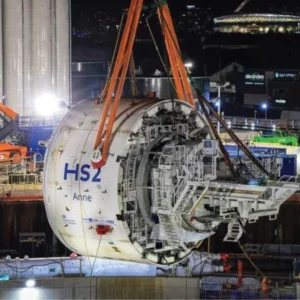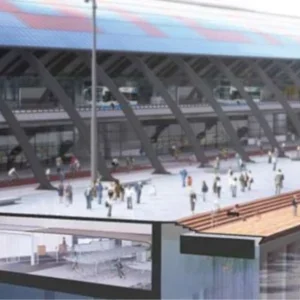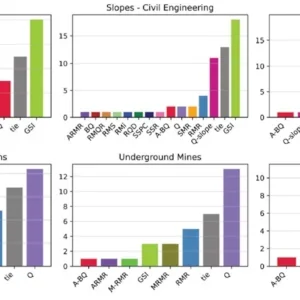Using microtunnelling technology, it was possible to lay a high-voltage power line between spring and autumn 2002 amid the nose-to-tail traffic of Hong Kong’s metropolis. Without affecting traffic, a 1,800mm diameter Herrenknecht AVN jacked two tunnels, of 420m each, through rock with compressive strengths of more than 400MPa, setting a new benchmark for the application of AVN machines.
According to the 10-year plan of the Hong Kong Special Administrative Region (SAR) Government, the power supply for the industrial zone of Ap Lei Chau must be improved by using new high-voltage power lines. Therefore, four 132kV cables, ten 11kV cables, and several spare cables for regulation and communication, had to be laid between the bridge leading to the Aberdeen district and the power supply substation of the industrial zone. However, so many underground cables already run under Lee Nam Road (the only high-capacity road between the bridge and the industrial zone), laying further cables would risk the danger of inductive interference and heating-up. Therefore, based on a survey by Atkins China, the authorities opted for a new 420m long cable tunnel, being the shortest route between the industrial zone and the bridge.
The tunnel, with vertical cover of up to 110m, crosses the island hill Ap Lei Chau. The geological survey showed that the tunnel had to be jacked through ignimbrite (densely welded ash-flow tuff), which is typical for Hong Kong. An analysis of the rock features produced 5.6 on the Cerchar Abrasivity Index, compressive strengths of partially more than 400MPa and tensile strengths of approximately 20MPa. Being composed of quartz, feldspar and biotite, the structure of the matrix is extremely fine-grained and thus, the mineral phases are finely intergrown.
Due to the tight construction schedule and the expected large quantity of crevasse water, the contractor Nishimatsu together with subcontractors (Fine Projects Ltd & Complant Hong Kong JV) opted for the use of pipe jacking and a Herrenknecht AVN 1800T microtunnelling machine.
The machine, with a total length of 12.5m, is equipped with air lock technology so that pipe jacking and tool changing do not depend on the expected inflow of water.
Machine technology
The AVN 1800T is a remote-controlled machine with slurry material removal. One characteristic of the T-series is the peripheral drive that enables face access via a door installed in the centre of the machine. The concept of the T-series combines the requirements of a large bearing and high-performance drive. The modular design of the machine in combination with a compact jacking frame, enables launch from a shaft with a length of less than 6m. The cutterhead is equipped with discs of 11in-12in, all of which are accessible from behind, minimising exposure time for replacement and improving safety. Despite a reduced number of cutter discs compared to a hard rock machine, tunnelling performance reached up to 25mm/min, however, the high abrasivity caused a high amount of wear.
The 200kW drive is infinitely variable up to a maximum of 11rpm. The rotational speed is automatically restricted when nearing the maximum torque so that the drive does not block in case of torque peaks. The drive works with a torque of up to 474kNm.
Process engineering
A key element of pipe jacking through hard rock is the friction conditions. Fine particles may accumulate in the overcut and deteriorate the friction conditions, if they are compressed in the overcut the pipe may get stuck. The quantity of fines depends on the geology and also on the design of the cutterhead. A large number of tools cause a high percentage of fine particles during slow tunnelling. The ideal lubricating film between the pipes and the substrate is therefore a decisive factor for successful tunnelling.
Bentonite in the overcut as well as a high-performance feed pump helped to avoid the permeation of the fines during the boring process. It is more difficult to control the fines, which slip through gaps of the backward area into the overcut. This permeation, caused by the geology, can only be avoided by consistent lubrication of the annulus. Bentonite does not only reduce friction but also helps avoiding the break down and blocking of material. An automatic bentonite lubrication system is necessary so that the lubrication of the piping can be specifically adjusted to the route. The launch seal is also an important part of the lubrication process, as it must seal perfectly, otherwise the fine particles move uncontrollably together with the escaping bentonite.
The ideal interaction of man and machine is vital for the successful realisation of a project. For instance, lubrication cannot compensate for an overcut which is too low. Therefore, overcut has to be adjusted to the expected steering movements and the turning radius as well as the permissible wear and tear of the discs.
Tunnelling in Hong Kong started in March 2002. The first of the two tunnels, with an excavated diameter of 2,192mm, was finished in June 2002. The experience gained during this drive helped to optimise tunnelling on the second section and therefore the time could be reduced considerably. The second drive was finished in September 2002. With its performance in complex geological conditions, the machine ensured tight adherence to time and cost schedules.






